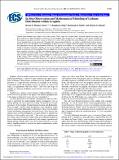In Situ Observation and Mathematical Modeling of Lithium Distribution within Graphite
Author(s)
Thomas-Alyea, Karen E; Jung, Changhoon; Smith, Raymond B; Bazant, Martin Z
DownloadPublished version (1.575Mb)
Terms of use
Metadata
Show full item recordAbstract
© The Author(s) 2017. Published by ECS. All rights reserved. Lithium forms ordered stages when it reacts with graphite. These stages have distinct colors; therefore, optical microscopy gives direct information about the lithium concentration in the graphite. Here we present in situ optical images during charging and discharging of a graphite electrode. Stages are observed to coexist with each other even after extended rest. There is considerable spatial nonuniformity on the microscale. To predict this concentration distribution, we employ a model which combines porous-electrode theory and Cahn-Hilliard phase-field theory to describe the flux of lithium within the graphite. The model closely matches the experimental voltage and concentration distribution. The spatial nonuniformity can be approximated with a relatively simple model of distributed resistances. Finally, we discuss the implications of using the phase-field model instead of a solid-solution model for prediction of lithium plating. The two models give similar predictions of cell voltage and risk of lithium plating under many operating conditions, with the main difference being the relaxation of concentration gradients within particles during rest. The distributed-resistance model shows a higher risk of lithium plating because well-connected particles are overworked as their more-resistive neighbors require a higher driving force for passage of current.
Date issued
2017Department
Massachusetts Institute of Technology. Department of Chemical EngineeringJournal
Journal of The Electrochemical Society
Publisher
The Electrochemical Society